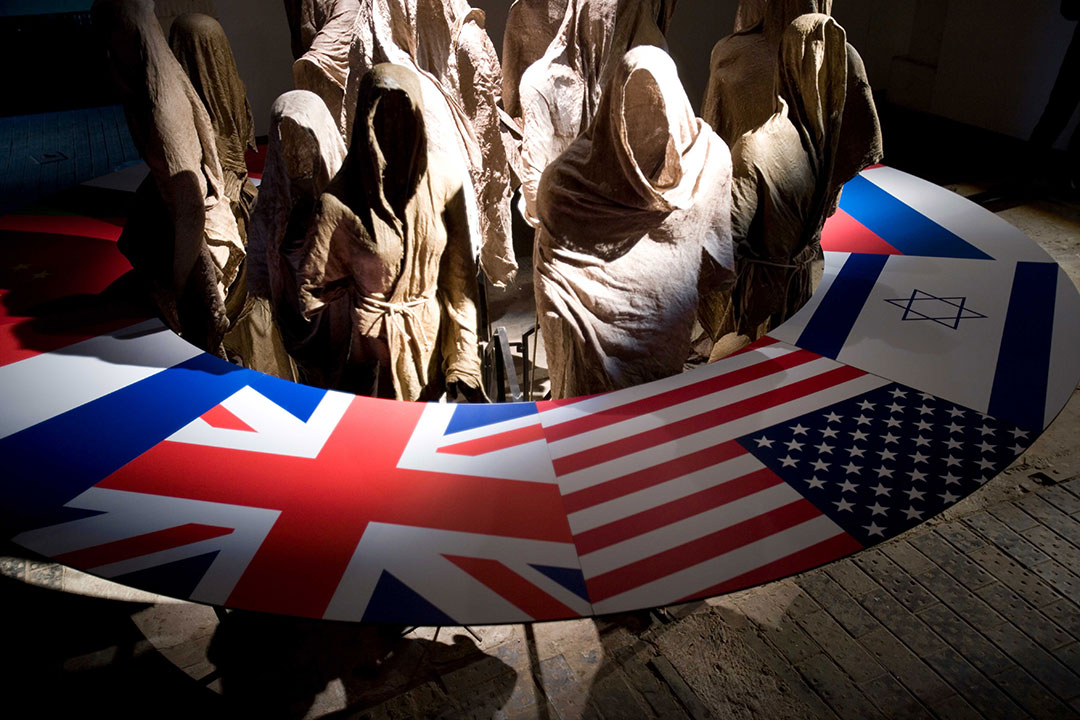Monumental-poetic method of representation in a form of unfolded spatial installation has become, apparently, the favorite creative style of the last two years for the artist Raffie Davtian.
Stylistic scope of his work of that period of time (the projects “Human Doors”, “The Last Supper Menu”) is in tune with problems not less voluminous by its significance problems, which are risen in it by the artist: the problems of the subjects, which are in the position of possession and objects –subalterns in the history of identities. Read More
In the artistic project “The Last Supper Menu” the problem of identities is represented with all its polyvalence.
The issue of engineering of identities in the context of new national states, in contrast with its universal belonging to a unified Soviet past, which had risen before “former Soviet” nations, along with the emerged in post-Soviet contexts not less urgent topic of rethinking gender-role functions (the project “Human Doors”), so-called gender problematic, absorbing into itself also the problems of racial, ethnic, national identities, are for this republics today probably the most dramatic, painfully experiencing and, sometimes, bloody.
Definitely, the new dimension in understanding of these topics had arrived from that moment, when the post-Soviet present provides possibility of penetration into it of the debates on the following topics: post-colonial, totalitarian regimes, ethnic minorities, sexism, gender issues, feminism, other types of subjectivity, expanding the thematics of identity with the following enrichment of subject –object (authority-dependent) relations as inside the local contexts, as well as in its inclusion in the discourse of the global processes.
In the installation “The Last Supper Menu” the problem of national identity of the former Soviet republics, declared themselves as new subject of history, after the collapse of 1/6-th part of the world geography, is presented in the capacity of a flowing, variable aspect.
The preliminary national-liberation euphoria and the possibility of “truly” democratic orientation with an integration with the world community, had changed by the comprehension of own objectness – a new sub alternation in the face of developed Western countries, who had not accepted at all the newly emerged states in their own ranks on equal terms.
The installation consists of human figures-objects, constructed from petrified drape, reminding of the robes of Christian Apostles – absolutely hollow inside. The number of the figures- mannequins, coincides by its number with the number of 15 republics, which were the part of the USSR and are presenting symbolically these republics.
The artist as if “picks out” Russian from that composition, laying out the state flag on the circular table, framing the figures, along with the other flags of the other world powers and countries, which were distinguished by the policies of colonization, seizure, genocide.
The reference to the well-known picture of Da Vinci “The Last Supper” is representing the topic of betrayal and faithfulness, the guilt and repentance. Evangelical “Last Supper” as a visionistic prediction of degeneration of faith and ideological consistency into betrayal and greed is akin to the transformed Soviet faith.
The blind faith of many representatives of the Soviet people in the fact, that the propaganda of Soviet apparatus of governance cannot be a manipulative one has superseded by devastation of that faith with following after it a not less apology of “wild” capitalistic economy, corruption, despotism of authorities in post-Soviet period.
Fifteen figures, presented in the project are appearing before us as immaterial ones, something like partially materialized symbols or partial objects, if one uses psychoanalysis language, in the context of global politics, because its new “inclusion” into history turns out to be a history of eviction of the “Other” into a non-possession paradigm.
If the status of non-possession of Soviet republics was built in interrelation with one center, with Moscow, then in installation the present multiplicity of the centers for the post-Soviet countries is represented, in a form of symbols-flags of the countries, more powerful with respect to the post-Soviet countries, laid out on a circular table.
The figure-objects performed in their full-length, crammed as a dense crowd in the center of the table, are captured by its closed circle, without any thresholds for “Exit”.
On the other hand, the figures-phantoms are pushed aside, they are estranged also from one another: being in brotherhood, these figures of national are represented in the installation in different weight categories: their sizes (bigger, smaller) and forms of feminine masculine are also referring to the verticals of relation, to subject-object asymmetry.


